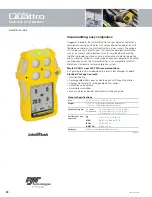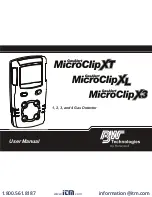
- 7 -
2-3. Precautions
CAUTION
Do not use the detector where it is exposed to oil, chemicals, etc. Do not submerge the detector
under water on purpose.
•
Do not use in a place where the detector is exposed to liquids such as oil and chemicals.
•
The detector is not water-pressure-resistant. Do not use the detector where a high water pressure is
applied to it (under a faucet, shower, etc.) or submerge it under water for a long time. The detector
is water-proof only in fresh water and running water, and not in hot water, salt water, detergent,
chemicals, human sweat, etc.
•
The gas inlet and outlet are not water-proof. Be careful not to let water such as rainwater, etc. get
into these parts. Because this may cause trouble and gas cannot be detected.
•
Do not place the detector where water or dirt gets accumulated. The detector placed at such a
location may cause malfunction due to water or dirt that gets into the buzzer opening, etc.
•
Note that drawing in dirty water, dust, metallic powder, etc. will significantly deteriorate the sensor
sensitivities. Be careful when the detector is used in an environment where these elements exist.
Do not use the detector in a place where the temperature drops below -20ºC or rises over 55ºC.
•
The operating temperature of the detector is -20 to +55ºC. Do not use the detector at higher
temperatures, humidities and pressures or at lower temperatures than the operating range.
•
Avoid long-term use of the detector in a place where it is exposed to direct sunlight.
•
Do not store the detector in a sun-heated car.
•
Avoid a sudden humidity or temperature change.
•
Do not leave the detector in a place with high temperature and humidity for a long time. The
performance of the unit may deteriorate.
Observe the operating restrictions to prevent condensation inside the concentration meter or gas
sampling hose.
•
Condensation formed on the detector or taper nozzle causes clogging, gas adsorption, etc., which
may disturb accurate gas detection. Thus, condensation must be avoided. In addition to the
installation environment, carefully monitor the temperature/humidity of the sampling point to prevent
condensation, etc. on the detector or taper nozzle. Please observe the operating restrictions.
Do not use a transceiver near the detector.
•
Radio wave from a transceiver or other device near the detector may disturb readings. If a
transceiver or other radio wave transmitting device is used, it must be used in a place where it
disturbs nothing.
•
Do not use the detector near a device that emits strong electromagnetic waves (high-frequency or
high-voltage devices).
Verify that the flow check display is rotating before using the detector.
•
If the flow check display is not rotating, the detector is not operating properly. Check whether the
flow rate is lost.
Never fail to perform a regular maintenance.
•
Since this is a precision device, a regular maintenance must be performed. Continuing to use the
detector without performing maintenance will compromise the sensitivity of the sensor, thus
resulting in inaccurate gas detection.








































